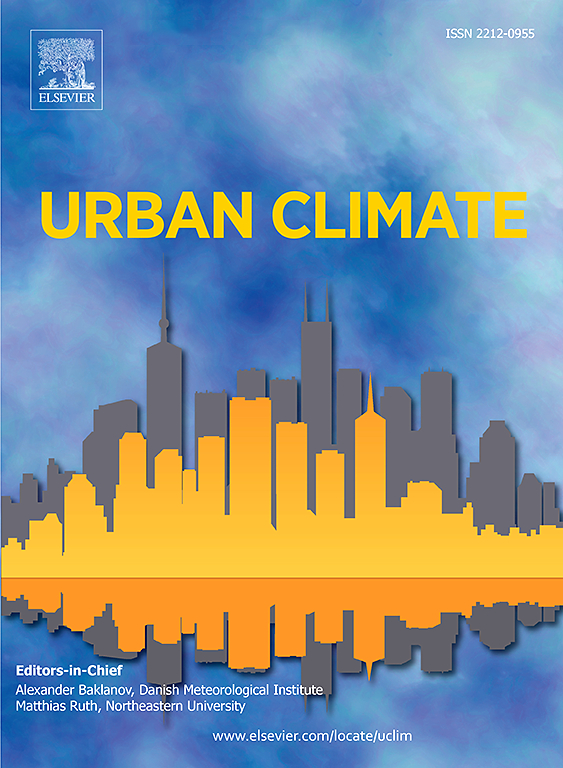绘制环境对城市形态步行行为的影响:基于局地气候带的研究
IF 6.9
2区 工程技术
Q1 ENVIRONMENTAL SCIENCES
引用次数: 0
摘要
步行在促进更健康和更可持续的城市中发挥着关键作用,但其环境决定因素往往在没有考虑三维城市形态的情况下进行研究。本研究引入了一个基于局部气候区(LCZ)分类的形态敏感框架,以评估建筑环境、气候和空气污染因素如何共同影响不同城市形态的步行。城市形态是建筑高度和密度的组合,由LCZ框架定义。利用来自中国深圳的大尺度步行轨迹数据,我们应用了极端梯度增强(XGBoost)和SHAPley加性解释(SHAP)来识别全市范围内和七种lcz定义的形态类型的关键环境因子。结果表明,不同城市形态对步行的环境影响存在显著差异。在低层区域,交通通道和步行功能支持步行,而自然环境(如NDVI和靠近水)则起次要作用;空气污染日益限制在高密度环境中行走。中高层中密度区域呈现过渡状态,交通通道、可步行性特征和自然环境发挥了积极作用,但空气污染和热量会产生适度抑制。相比之下,高层地区受到空气污染和高温的强烈复合抑制,而绿色基础设施的效益越来越小。这些发现挑战了环境-步行关系的空间均匀性假设,并强调了城市形态的调节作用。通过将LCZ分类与可解释的机器学习相结合,本研究提供了一种新的方法来识别特定形式的步行环境限制,为气候适应性城市设计提供可操作的见解。本文章由计算机程序翻译,如有差异,请以英文原文为准。
Mapping environmental influences on walking behavior across urban morphologies: A local climate zone-based study
Walking plays a critical role in promoting healthier and more sustainable cities, yet its environmental determinants are often examined without considering three-dimensional urban morphology. This study introduces a morphology-sensitive framework based on the Local Climate Zone (LCZ) classification to evaluate how built environment, climate, and air pollution factors jointly influence walking across distinct urban forms. Urban morphology is operationalized as a combination of building height and density, defined by the LCZ framework. Using large-scale walking trajectory data from Shenzhen, China, we applied Extreme Gradient Boosting (XGBoost) with SHAPley Additive exPlanations (SHAP) to identify key environmental factors at the citywide scale and across seven LCZ-defined morphological types.
Results reveal that environmental influences on walking vary significantly by urban morphology. In low-rise zones, walking is supported by transit access and walkability features, while natural environments such as NDVI and proximity to water play a minor role; air pollution increasingly constrains walking in high-density settings. Mid-rise medium-density zones present a transitional condition, where transit access, walkability features, and natural environments contribute positively, yet moderate suppression from air pollution and heat occurs. In contrast, high-rise areas experience strong compounded suppression from both air pollution and heat, while the benefits of green infrastructure become increasingly marginal.
These findings challenge the assumption of spatial uniformity in environment–walking relationships and highlight the moderating role of urban morphology. By integrating LCZ classification with interpretable machine learning, this study offers a novel approach to identify form-specific environmental constraints on walking, providing actionable insights for climate-adaptive urban design.
求助全文
通过发布文献求助,成功后即可免费获取论文全文。
去求助
来源期刊

Urban Climate
Social Sciences-Urban Studies
CiteScore
9.70
自引率
9.40%
发文量
286
期刊介绍:
Urban Climate serves the scientific and decision making communities with the publication of research on theory, science and applications relevant to understanding urban climatic conditions and change in relation to their geography and to demographic, socioeconomic, institutional, technological and environmental dynamics and global change. Targeted towards both disciplinary and interdisciplinary audiences, this journal publishes original research papers, comprehensive review articles, book reviews, and short communications on topics including, but not limited to, the following:
Urban meteorology and climate[...]
Urban environmental pollution[...]
Adaptation to global change[...]
Urban economic and social issues[...]
Research Approaches[...]
 求助内容:
求助内容: 应助结果提醒方式:
应助结果提醒方式:


